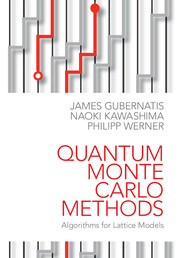Book contents
- Frontmatter
- Contents
- Preface
- Part I Monte Carlo basics
- 1 Introduction
- 2 Monte Carlo basics
- 3 Data analysis
- 4 Monte Carlo for classical many-body problems
- 5 Quantum Monte Carlo primer
- Part II Finite temperature
- Part III Zero temperature
- Part IV Other topics
- Appendix A Alias method
- Appendix B Rejection method
- Appendix C Extended-ensemble methods
- Appendix D Loop/cluster algorithms: SU(N) model
- Appendix E Long-range interactions
- Appendix F Thouless's theorem
- Appendix G Hubbard-Stratonovich transformations
- Appendix H Multi-electron propagator
- Appendix I Zero temperature determinant method
- Appendix J Anderson impurity model: chain representation
- Appendix K Anderson impurity model: action formulation
- Appendix L Continuous-time auxiliary-field algorithm
- Appendix M Continuous-time determinant algorithm
- Appendix N Correlated sampling
- Appendix O The Bryan algorithm
- References
- Index
1 - Introduction
from Part I - Monte Carlo basics
Published online by Cambridge University Press: 05 May 2016
- Frontmatter
- Contents
- Preface
- Part I Monte Carlo basics
- 1 Introduction
- 2 Monte Carlo basics
- 3 Data analysis
- 4 Monte Carlo for classical many-body problems
- 5 Quantum Monte Carlo primer
- Part II Finite temperature
- Part III Zero temperature
- Part IV Other topics
- Appendix A Alias method
- Appendix B Rejection method
- Appendix C Extended-ensemble methods
- Appendix D Loop/cluster algorithms: SU(N) model
- Appendix E Long-range interactions
- Appendix F Thouless's theorem
- Appendix G Hubbard-Stratonovich transformations
- Appendix H Multi-electron propagator
- Appendix I Zero temperature determinant method
- Appendix J Anderson impurity model: chain representation
- Appendix K Anderson impurity model: action formulation
- Appendix L Continuous-time auxiliary-field algorithm
- Appendix M Continuous-time determinant algorithm
- Appendix N Correlated sampling
- Appendix O The Bryan algorithm
- References
- Index
Summary
A quantum Monte Carlo method is simply a Monte Carlo method applied to a quantum problem. What distinguishes a quantum Monte Carlo method from a classical one is the initial effort necessary to represent the quantum problem in a form that is suitable for Monte Carlo simulation. It is in making this transformation that the quantum nature of the problem asserts itself not only through such obvious issues as the noncommutivity of the physical variables and the need to symmetrize or antisymmetrize the wave function, but also through less obvious issues such as the sign problem. Almost always, the transformation replaces the quantum degrees of freedom by classical ones, and it is to these classical degrees of freedom that the Monte Carlo method is actually applied. Succeeding chapters present and explain many of the quantum Monte Carlo methods being successfully used on a variety of quantum problems. In Chapters 1 and 2 we focus on discussing what the Monte Carlo method is and why it is useful.
The Monte Carlo method
The Monte Carlo method is not a specific technique but a general strategy for solving problems too complex to solve analytically or too intensive numerically to solve deterministically. Often a specific strategy incorporates several different Monte Carlo techniques. In what is likely the first journal article to use the phrase “Monte Carlo,” Metropolis and Ulam (1949) discuss this strategy. To paraphrase them,
The Monte Carlo method is an iterative stochastic procedure, consistent with a defining relation for some function, which allows an estimate of the function without completely determining it.
This is quite different from the colloquialism, “a method that uses random numbers.” Let us examine the definition piece by piece. A key point will emerge.
Ulam and Metropolis were presenting the motivation and a general description of a statistical approach to the study of differential and integro-differential equations. These equations were their “defining relation for some function.” The “function” was the solution of these equations. This function is of course unknown a priori. Metropolis, Rosenbluth, Rosenbluth, Teller, and Teller (1953) a few years later would propose a statistical approach to the study of equilibrium statistical mechanics. The defining relation there was a thermodynamic average of a physical quantity over the Boltzmann distribution. The function was the physical quantity, and the unknown its average.
- Type
- Chapter
- Information
- Quantum Monte Carlo MethodsAlgorithms for Lattice Models, pp. 3 - 10Publisher: Cambridge University PressPrint publication year: 2016

